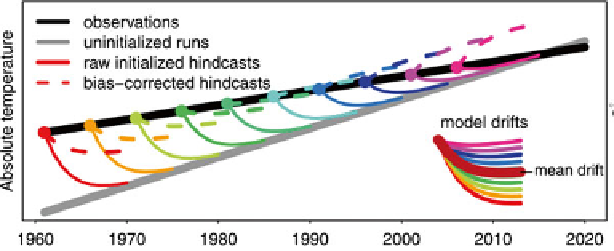Geoscience Reference
In-Depth Information
Fig. 16.4
Schematic illustrating bias and trend correction of decadal forecasts. Initialized predic-
tions (coloured solid curves) drift from observed states (
black
) towards the climate of uninitialized
simulations (
grey
). Coloured dashed curves indicate residual drifts that remain when the bias is
corrected for and require further correction to match model and observed trends (Adapted from
Kharin et al.
2012
)
There are many different techniques for initializing models with observations,
ranging from simple optimal interpolation to more sophisticated 4D-var and ensem-
ble Kalman fi lters. A full description is beyond the scope of this topic, and further
details are available in NRC (
2010
) and Balmaseda et al. (
2009
). Initialization of the
ocean is crucial for decadal forecasts, but ocean assimilation is less mature than
atmosphere assimilation and is complicated by the historical scarcity of observa-
tions. Furthermore, initialization of the land surface and cryosphere are only in early
stages of development, partly due to the lack of observations of key quantities such
as soil moisture and sea ice thickness.
Uncertainties in forecasts are inevitable. This is because initial conditions will
never be known precisely for all variables, climate models are imperfect and future
external forcings are only partly known. The relative importance of these different
sources of uncertainty in uninitialized climate projections of rainfall is illustrated
in Fig.
16.5
. On decadal timescales uncertainties in well-mixed greenhouse gas
scenarios are relatively minor (see Fig.
16.5
right hand panels), although aerosol
and solar uncertainties and possible future volcanic eruptions are potentially impor-
tant (not shown). Internal variability is the largest source of uncertainty (see
Fig.
16.5
left hand panels), and may be reduced through initialization, but uncer-
tainties in model responses are also signifi cant (see Fig.
16.5
middle panels).
Decadal forecasts therefore consist of ensembles of model integrations that attempt
to sample the relevant uncertainties. Initial condition uncertainties are typically
sampled by perturbing winds and ocean conditions, or with a lagged average
approach that combines forecasts starting from different dates. Neither of these
approaches necessarily samples the true uncertainties, especially below the ocean
surface. Modelling uncertainties are sampled either by perturbing model parame-
ters to create an ensemble of variants of a particular model (Smith et al.
2010
) or
by combining forecasts from different centres to create a multi-model ensemble
(Palmer et al.
2004
).

Search WWH ::

Custom Search